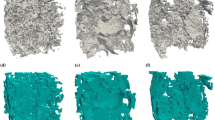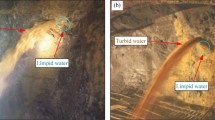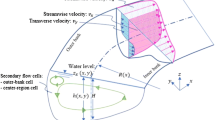Abstract
The wave interaction with stratified porous structure combined with a surface-piercing porous block in a stepped seabed is analysed based on the small amplitude wave theory. The study is performed to analyse the effectiveness of partial porous structure in increasing the wave attenuation in the nearshore regions consisting of stratified porous structures of different configurations using the eigenfunction expansion method and orthogonal mode-coupling relation. The hydrodynamic characteristics such as wave reflection coefficient, transmission coefficient, dissipation coefficient, wave force impact and surface elevation are investigated due to the presence of both horizontally and vertically stratified porous structures. The effect of varying porosity, structural width, angle of incidence, wavelength and length between the porous block and stratified structure is examined. The numerical results are validated with the results available in the literature. The present study illustrates that the presence of the stratified structure decreases wave transmission and efficient wave attenuation can also be easily achieved. The wave force acting on stratified structure can be decreased if the structure is combined with wider surface-piercing porous blocks. Further, the presence of stratified porous structure combined with porous block helps in creating a tranquil zone in the leeside of the structure. The combination of vertical and horizontal stratified porous structure with surface-piercing porous block is intended to be an effective solution for the protection of coastal facilities.
Similar content being viewed by others
Abbreviations
- C m :
-
Added mass coefficient
- C f :
-
Turbulent resistant coefficient
- ε 2 :
-
Porosity of the surface piercing porous block
- ε 5 :
-
Porosity of the surface or seaward porous layer
- ε 6 :
-
Porosity of the bottom or leeward porous layer
- f 2 :
-
Frictional coefficient of surface piercing porous block
- f 5 :
-
Frictional coefficient of surface or seaward porous layer
- f 6 :
-
Frictional coefficient of bottom or leeward porous layer
- g :
-
Acceleration due to gravity
- I 10 :
-
Complex amplitude of incident wave energy
- i:
-
Imaginary number
- K d :
-
Energy dissipation coefficient
- K fb1 :
-
Wave force coefficient on front face of porous block
- K fs1 :
-
Wave force coefficient on front face of stratified porous structure
- k jn :
-
Wave number in x–direction
- K r :
-
Reflection coefficient
- K t :
-
Transmission coefficient
- L :
-
Gap between the porous block and stratified porous structure
- l :
-
Wave number in z–direction
- M :
-
Number of evanescent wave modes
- q :
-
Instantaneous Eularian velocity vector
- R 10 :
-
Complex amplitude of reflected wave energy
- S 2 :
-
Reactance coefficient of surface piercing porous block
- S 5 :
-
Reactance coefficient of surface or seaward porous layer
- S 6 :
-
Reactance coefficient of bottom or leeward porous layer
- t :
-
Time
- T :
-
Wave period
- T 90 :
-
Complex amplitude of transmitted wave energy
- V :
-
Volume
- w 1 :
-
Width of the porous block
- w 2 :
-
Width of the stratified porous structure
- ω :
-
Wave frequency
- x :
-
Horizontal distance along x–direction
- y :
-
Vertical distance along y–direction
- γ jn :
-
Wave number in y–direction
- θ :
-
Incident wave angle
References
Ashok R, Manam SR (2022) Oblique wave scattering problems involving vertical porous membranes. Journal of Marine Science and Application 21: 51–66. https://doi.org/10.1007/s11804-022-00255-0
Behera H, Ghosh S (2019) Oblique wave trapping by a surface-piercing flexible porous barrier in the presence of step-type bottoms. Journal of Marine Science and Application 18: 433–443. https://doi.org/10.1007/s11804-018-0036-2
Dalrymple RA, Losada MA, Martin PA (1991) Reflection and transmission from porous structures under oblique wave attack. Journal of Fluid Mechanics 224: 625–644. https://doi.org/10.1017/S0022112091001908
Dattatri J, Raman H, Shankar NJ (1978) Performance characteristics of submerged breakwaters. In Coastal Engineering Proceedings, Hamburg, 2153–2171. https://doi.org/10.9753/icce.v16.130
Das S, Bora SN (2014) Reflection of oblique ocean water waves by a vertical rectangular porous structure placed on an elevated horizontal bottom. Ocean Engineering 82: 135–143. https://doi.org/10.1016/j.oceaneng.2014.02.035
Hu J, Zhao Y, Liu PLF (2019) A model for obliquely incident wave interacting with a multi-layered object. Applied Ocean Research 87: 211–222. https://doi.org/10.1016/j.apor.2019.03.004
Karmakar D, Guedes Soares C (2014) Wave transformation due to multiple bottom-standing porous barriers. Ocean Engineering 80: 50–63. https://doi.org/10.1016/j.oceaneng.2014.01.012
Koley S, Behera H, Sahoo T (2015) Oblique wave trapping by porous structures near a wall. Journal of Engineering Mechanics 141(3): 04014122. https://doi.org/10.1061/(ASCE)EM.1943-7889.0000843
Koley S, Sahoo T (2017) Oblique wave trapping by vertical permeable membrane barriers located near a wall. Journal of Marine Science and Application 16: 490–501. https://doi.org/10.1007/s11804-017-1432-8
Kondo H, Toma S (1972) Reflection and transmission for a porous structure. Coastal Engineering Proceedings 1(13): 1847–1866. https://doi.org/10.9753/icce.v13.100
Liu Y, Li H (2013) Wave reflection and transmission by porous breakwaters: A new analytical solution. Coastal Engineering 78: 46–52. https://doi.org/10.1016/jxoastaleng.2013.04.003
Liu Y, Li Y, Teng B (2007) Wave interaction with a new type perforated breakwater. Acta Mech Sin 23(4): 351–358. https://doi.org/10.1007/s10409-007-0086-1
Madsen PA (1983) Wave reflection from a vertical permeable wave absorber. Coastal Engineering 7(4): 381–396. https://doi.org/10.1016/0378-3839(83)90005-4
Mallayachari V, Sundar V (1994) Reflection characteristics of permeable seawalls. Coastal Engineering 23(1–2): 135–150. https://doi.org/10.1016/0378-3839(94)90019-1
Mendez FJ, Losada IJ (2004) A perturbation method to solve dispersion equations for water waves over dissipative media. Coastal Engineering 51(1): 81–89. https://doi.org/10.1016/j.coastaleng.2003.12.007
Sahoo T, Lee MM, Chwang AT (2000) Trapping and generation of waves by vertical porous structures. Journal of Engineering Mechanics 126: 1074–1082. https://doi.org/10.1061/(ASCE)0733-9399(2000)126:10(1074)
Sollitt CK, Cross RH (1972) Wave transmission through permeable breakwaters. In Coastal Engineering, 1827–1846. https://doi.org/10.9753/icce.v13.99
Somervell LT, Thampi SG, Shashikala AP (2017) A novel approach for the optimal design of a vertical cellular breakwater based on multi-objective optimization. Coastal Engineering Journal 59(4): 1750019. https://doi.org/10.1142/S057856341750019X
Sulisz W (1985) Wave reflection and transmission at permeable breakwaters of arbitrary cross-section. Coastal Engineering 9(4): 371–386. https://doi.org/10.1016/0378-3839(85)90018-3
Tabssum S, Kaligatla RB, Sahoo T (2020) Gravity wave interaction with a porous breakwater in a two-layer ocean of varying depth. Ocean Engineering 196: 106816. https://doi.org/10.1016/j.oceaneng.2019.106816
Twu SW, Chieu CC (2000) A highly wave dissipation offshore breakwater. Ocean Engineering 27(3): 315–330. https://doi.org/10.1016/S0029-8018(99)00002-5
Twu SW, Lin DT (1990) Wave reflection by a number of thin porous plates fixed in a semi-infinitely long flume. In Coastal Engineering Proceedings, Delft, 1046–1059. https://doi.org/10.1061/9780872627765.081
Twu SW, Liu CC, Twu CW (2002) Wave damping characteristics of vertically stratified porous structures under oblique wave action. Ocean Engineering 29(11): 1295–1311. https://doi.org/10.1016/S0029-8018(01)00091-9
Venkateswarlu V, Praveen KM, Karmakar D (2020a) Surface gravity wave scattering by multiple energy absorbing structures of variable horizontal porosity. Coastal Engineering Journal 62(4): 504–526. https://doi.org/10.1080/21664250.2020.1794274
Venkateswarlu V, Karmakar D (2020b) Significance of seabed characteristics on wave transformation in the presence of stratified porous block. Coastal Engineering Journal 62(1): 1–22. https://doi.org/10.1080/21664250.2019.1676366
Venkateswarlu V, Karmakar D (2020c) Wave motion over stratified porous absorber combined with seaward vertical barrier. Proceedings of the Institution of Mechanical Engineers, Part M: Journal of Engineering for the Maritime Environment 234(4): 830–845. https://doi.org/10.1177/1475090220912643
Yu X, Chwang AT (1994) Wave motion through porous structures. Journal of Engineering Mechanics 120(5): 989–1008. https://doi.org/10.1061/(ASCE)0733-9399(1994)120:5(989)
Zhu S, Chwang AT (2001) Analytical study of porous wave absorber. Journal of Engineering Mechanics 127(4): 326–332. https://doi.org/10.1061/(ASCE)0733-9399(2001)127:4(326)
Acknowledgement
The authors acknowledge Science and Engineering Research Board (SERB), Department of Science & Technology (DST), Government of India for supporting financially under the research grant No. CRG/2018/004184 and Ministry of Ports, Shipping and Waterways, Government of India through the research grant No. DW/01013(13)/2/2021.
Author information
Authors and Affiliations
Corresponding author
Ethics declarations
Competing interest D. Karmakar is an editorial board member for the Journal of Marine Science and Application and was not involved in the editorial review, or the decision to publish this article. All authors declare that there are no other competing interests.
Additional information
Article Highlights
• The hydrodynamic performance of stratified porous structure combined with a surface-piercing porous block in a stepped seabed is analysed using small amplitude wave theory.
• The effect of structural and geometrical parameters due to stepped bottom configuration are analysed for the compsite breakwater system.
• The wave attenuation charecteristics along with wave force experience on the stratified breakwater and porous block due to stepped sea-bed is analysed.
Rights and permissions
About this article
Cite this article
Varghese, A., Athul Krishna, K.R. & Karmakar, D. Wave Attenuation due to Stratified Porous Structure with Stepped Seabed. J. Marine. Sci. Appl. (2024). https://doi.org/10.1007/s11804-024-00407-4
Received:
Accepted:
Published:
DOI: https://doi.org/10.1007/s11804-024-00407-4




